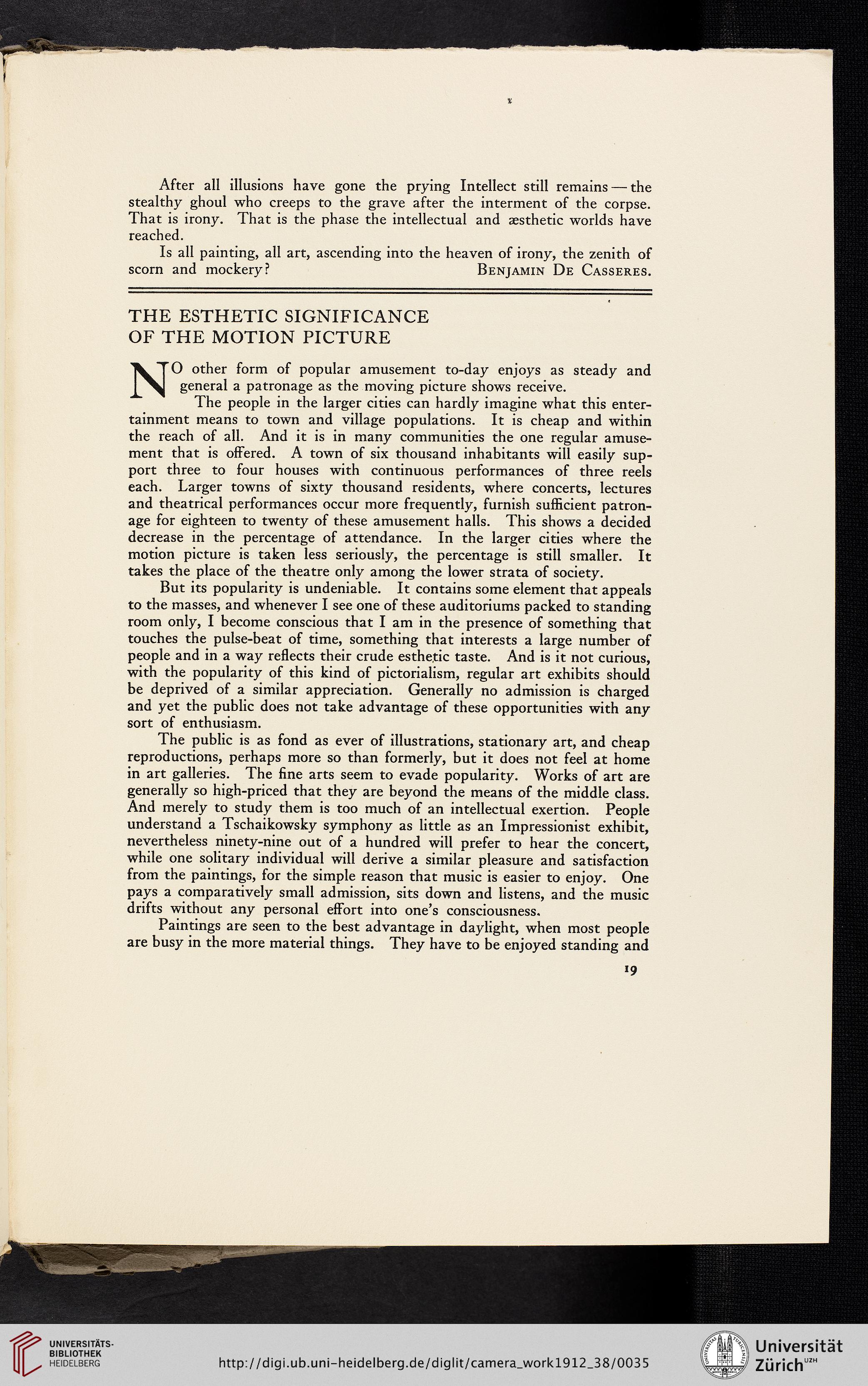Für diese Seite ist auch eine manuell angefertigte Transkription bzw. Edition verfügbar. Bitte wechseln Sie dafür zum Reiter "Transkription" oder "Edition".
After all illusions have gone the prying Intellect still remains — the
stealthy ghoul who creeps to the grave after the interment of the corpse.
That is irony. That is the phase the intellectual and aesthetic worlds have
reached.
Is all painting, all art, ascending into the heaven of irony, the zenith of
scorn and mockery? Benjamin De Casseres.
THE ESTHETIC SIGNIFICANCE
OF THE MOTION PICTURE
NO other form of popular amusement to-day enjoys as steady and
general a patronage as the moving picture shows receive.
The people in the larger cities can hardly imagine what this enter-
tainment means to town and village populations. It is cheap and within
the reach of all. And it is in many communities the one regular amuse-
ment that is offered. A town of six thousand inhabitants will easily sup-
port three to four houses with continuous performances of three reels
each. Larger towns of sixty thousand residents, where concerts, lectures
and theatrical performances occur more frequently, furnish sufficient patron-
age for eighteen to twenty of these amusement halls. This shows a decided
decrease in the percentage of attendance. In the larger cities where the
motion picture is taken less seriously, the percentage is still smaller. It
takes the place of the theatre only among the lower strata of society.
But its popularity is undeniable. It contains some element that appeals
to the masses, and whenever I see one of these auditoriums packed to standing
room only, I become conscious that I am in the presence of something that
touches the pulse-beat of time, something that interests a large number of
people and in a way reflects their crude esthetic taste. And is it not curious,
with the popularity of this kind of pictorialism, regular art exhibits should
be deprived of a similar appreciation. Generally no admission is charged
and yet the public does not take advantage of these opportunities with any
sort of enthusiasm.
The public is as fond as ever of illustrations, stationary art, and cheap
reproductions, perhaps more so than formerly, but it does not feel at home
in art galleries. The fine arts seem to evade popularity. Works of art are
generally so high-priced that they are beyond the means of the middle class.
And merely to study them is too much of an intellectual exertion. People
understand a Tschaikowsky symphony as little as an Impressionist exhibit,
nevertheless ninety-nine out of a hundred will prefer to hear the concert,
while one solitary individual will derive a similar pleasure and satisfaction
from the paintings, for the simple reason that music is easier to enjoy. One
pays a comparatively small admission, sits down and listens, and the music
drifts without any personal effort into one’s consciousness.
Paintings are seen to the best advantage in daylight, when most people
are busy in the more material things. They have to be enjoyed standing and
19
stealthy ghoul who creeps to the grave after the interment of the corpse.
That is irony. That is the phase the intellectual and aesthetic worlds have
reached.
Is all painting, all art, ascending into the heaven of irony, the zenith of
scorn and mockery? Benjamin De Casseres.
THE ESTHETIC SIGNIFICANCE
OF THE MOTION PICTURE
NO other form of popular amusement to-day enjoys as steady and
general a patronage as the moving picture shows receive.
The people in the larger cities can hardly imagine what this enter-
tainment means to town and village populations. It is cheap and within
the reach of all. And it is in many communities the one regular amuse-
ment that is offered. A town of six thousand inhabitants will easily sup-
port three to four houses with continuous performances of three reels
each. Larger towns of sixty thousand residents, where concerts, lectures
and theatrical performances occur more frequently, furnish sufficient patron-
age for eighteen to twenty of these amusement halls. This shows a decided
decrease in the percentage of attendance. In the larger cities where the
motion picture is taken less seriously, the percentage is still smaller. It
takes the place of the theatre only among the lower strata of society.
But its popularity is undeniable. It contains some element that appeals
to the masses, and whenever I see one of these auditoriums packed to standing
room only, I become conscious that I am in the presence of something that
touches the pulse-beat of time, something that interests a large number of
people and in a way reflects their crude esthetic taste. And is it not curious,
with the popularity of this kind of pictorialism, regular art exhibits should
be deprived of a similar appreciation. Generally no admission is charged
and yet the public does not take advantage of these opportunities with any
sort of enthusiasm.
The public is as fond as ever of illustrations, stationary art, and cheap
reproductions, perhaps more so than formerly, but it does not feel at home
in art galleries. The fine arts seem to evade popularity. Works of art are
generally so high-priced that they are beyond the means of the middle class.
And merely to study them is too much of an intellectual exertion. People
understand a Tschaikowsky symphony as little as an Impressionist exhibit,
nevertheless ninety-nine out of a hundred will prefer to hear the concert,
while one solitary individual will derive a similar pleasure and satisfaction
from the paintings, for the simple reason that music is easier to enjoy. One
pays a comparatively small admission, sits down and listens, and the music
drifts without any personal effort into one’s consciousness.
Paintings are seen to the best advantage in daylight, when most people
are busy in the more material things. They have to be enjoyed standing and
19


